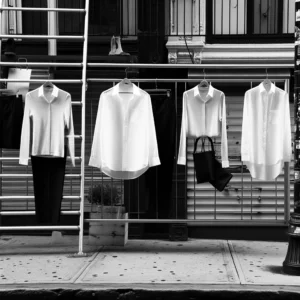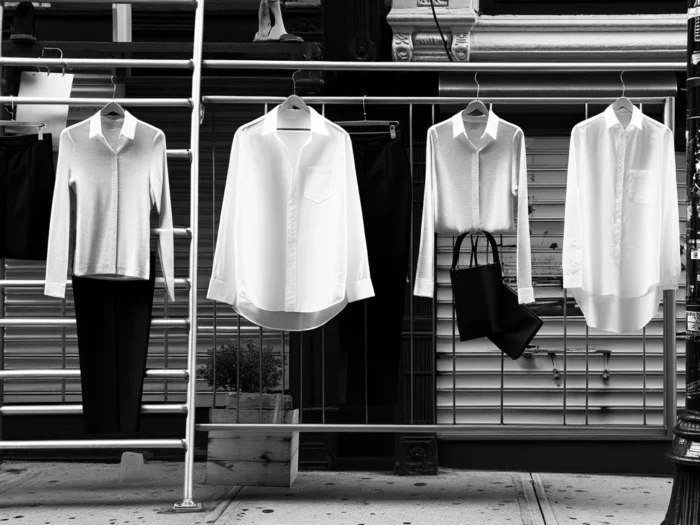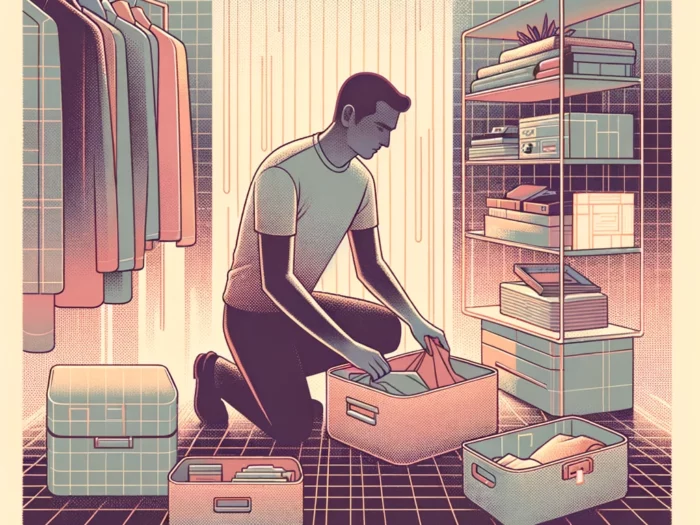- Introduction: My Journey Towards Embracing Generosity and Minimalism
- Understanding the Benefits of Generosity and Minimalism
- Step 1: Assessing Your Current Lifestyle and Mindset
- Step 2: Decluttering Your Physical Space
- Step 3: Letting Go of Material Possessions
- Step 4: Cultivating a Mindful and Present Attitude
- Step 5: Practicing Gratitude Daily
- Step 6: Incorporating Generous Acts into Your Routine
- Step 7: Finding Joy in Giving Back to Others
- Step 8: Building Stronger Relationships through Generosity
- Step 9: Simplifying Your Personal Finances
- Step 10: Prioritizing Experiences over Material Things
- Step 11: Practicing Self-Care and Self-Compassion
- Step 12: Embracing Imperfection and Letting Go of Perfectionism
- Step 13: Maintaining a Balanced Approach to Generosity and Minimalism
- Conclusion: Embracing a More Generous and Minimalistic Lifestyle
Introduction: My Journey Towards Embracing Generosity and Minimalism
I still remember that gloomy winter day when I looked around my home and felt a chill down my spine. It wasn’t because of the cold weather outside but the clutter that was inside. There were possessions strewn all over, possessions that had once brought joy but now only added to the anxiety. As I lugged another box of ‘essentials’ to yet another storage space that was overflowing with ‘indispensables’, I had a startling epiphany. I was not just emotionally exhausting myself but was also failing to give my time, energy, and resources to those who needed them more than my overflowing cupboards. I realized I was not living a life, I was barely managing an inventory.
It’s funny how our possessions end up possessing us, isn’t it? And that’s when it hit me: I was yearning for space. Space for a life that wasn’t stifled by stuff. Space for a life that could breathe generosity and give without measuring. I wanted to step into a journey from possession to donation, from hoarding to minimalism.
The road towards embracing generosity and minimalism hasn’t been easy, I won’t lie, but it has been incredibly fulfilling. Each step taken encourages me to shed the layers of unnecessary material possessions, and each act of generosity fills my being with an inexplicable joy. It’s a simple philosophy, really. The less we own, the less we have to worry about. And the more we give, the more we receive in terms of satisfaction and spiritual wealth.
The following steps are the treasured milestones of my journey. I hope they can lead you towards embracing a life of minimalism and generosity too. Let’s walk this path together, shall we?
Understanding the Benefits of Generosity and Minimalism
It was a sweltering summer day when I sat down on my dusty living room rug, surrounded by mounds of distractingly shiny nick-knacks, paintings I didn’t even know I had, and cupboards spilling over with … stuff. As I started sifting through the static of materialism, I couldn’t help but feel overwhelmed by the sheer quantity of possessions that were engulfing my space – and my spirit. I had to cut down on the clutter; in essence, I needed to embrace minimalism.
Yet, it wasn’t merely the mess I was hoping to get away from, it was the ‘more is better’ mentality that concerned me. The overconsumption, the ‘keeping up with the Joneses‘, the never-quenching thirst for more – it was depleting me. The stark reality is that our possessions don’t make us happier. In fact, research suggests that materialism can lead to dissatisfaction, depression, and anxiety.
On my journey to adopting a simpler lifestyle, I traded the accumulation of possessions for something infinitely more enriching – generosity. I started to donate, volunteer, and be more conscious about giving back to my community. The benefits of this mindset shift were immense and instantaneous. A study by the American Psychological Association shows how altruistic behavior directly correlates with increased happiness and well-being. The act of giving, as it turns out, isn’t just good for the soul, it’s science.
So, the question isn’t ‘why should I become more generous and minimalist?’, my friends, but ‘why shouldn’t I?’ Let’s dive into the thirteen steps that helped me embrace these principles and share the benefits along the way.
Step 1: Assessing Your Current Lifestyle and Mindset
As I embarked on my journey towards transforming into a more generous persona, I learned the critical importance of understanding where you currently stand. Whether we realize it or not, our lifestyles and mindset significantly shape our attitudes toward generosity and minimalism. So, my first suggestion is to take a step back and critically evaluate your existing lifestyle and way of thinking.
You may ask, “How can I do that?”.
Well, it’s simpler than it sounds. I began by listing down aspects of my life that took most of my attention – my possessions, my time, and my thoughts. You’d be surprised at what a simple, honest list can reveal about you!
Make a Checklist
Make a list of the things, notions, memories, or people that you hold onto. Include everything you feel you can’t do without; I mean EVERYTHING, even that old pair of jeans that doesn’t fit anymore but ‘Oh I remember when…’, and yes, your favorite mug that’s chipped from the side but ‘it’s just right for my coffee’. It may feel silly, but laying it all out there can bring clarity. This simple exercise revealed, to my embarrassment, that I was too attached to material things that hardly mattered.
Reflect on Your Checklist
Next, take time to reflect on each item on your list. Ask yourself why you’re holding onto it and what would happen if you let it go. This is an exercise in self-discovery – you’ll gain deep insights into your attachments and the reasons behind them. For me, I realized I often clung to things because of the memories associated with them, which was an eye-opening revelation!
Identify Areas for Improvement
After this exercise, you’ll have a clear picture of your current lifestyle and mindset, which is the starting point to becoming more generous and minimalist. But remember, self-awareness without action is futile. Identify areas that require change and promise yourself you’ll work on them. I found my attachment to materialistic things was something I needed to reduce drastically.
Before we move on, let me add – don’t beat yourself up if you find areas of your life less than perfect. Remember, we’re on this journey together, and nobody is expecting you to change overnight. In fact, I’m still a work in progress. But recognizing where I was going wrong was the first step, as it is for everyone, to becoming more generous and minimalist.
This step requires introspection and brutal honesty, but trust me, it’s worth it. It gives you a realistic perspective of your current behaviors and the scope of the journey ahead.
Step 2: Decluttering Your Physical Space
There are few experiences as cathartic and liberating as decluttering your living space. I still remember the first day I decided to embark on this journey of decluttering. I stood in my living room, scanning the room filled with books, knick-knacks, furniture, and I took a deep breath. The task seemed daunting, almost overwhelming. However, in that very moment, I realized that this was another crucial step towards becoming more minimalistic and generous.
Clutter can often become an insidious part of our lives. Each object that we own has a story, an attachment, and letting go is rarely easy. I’ll let you in on a little secret though – the relief and freedom you feel afterwards is well worth the struggle. Here’s how I approached this monumental task and how you can too:
- Begin with one room at a time. Taking on the whole house can seem overwhelming. Break down the task into smaller, more manageable parts.
- Separate your items into four categories: ‘keep’, ‘donate’, ‘sell’ and ‘recycle’. This makes the decision-making process easier and more systematic.
- Be ruthless but fair. If you haven’t used an item in a year, it’s probably time for it to find a new home.
- When decluttering, always bear in mind the end goal. Each item you eliminate is a step closer to a more minimalistic lifestyle.
One important thing to remember – don’t rush the process. Decluttering, much like generosity, is not an act but a habit. It will take time. Believe me, the more you do it, the easier it becomes and the better you‘ll feel. The weight that lifts off your shoulders, as each unnecessary item leaves your space, is palpable.
The Joy of Sharing
Perhaps one of the most fulfilling aspects of decluttering comes from the act of donating. In giving away items no longer needed, I discovered a newfound joy in sharing. There is something incredibly satisfying about an item you no longer require, finding purpose in a new home. My hypersize collection of cookbooks? It may have been overkill for me, but for a local community library, it was a bonanza!
As we progress on this journey to becoming more minimalist and generous people, these physical acts of giving form part of the foundation. They not only help declutter our physical space but also detoxify our mental space, making way for a new, more generous worldview.
I continue to declutter regularly now – it has become an integral part of my minimalist living. And for those of you beginning this journey, take heart! With time, patience and perseverance, you’ll find this task less daunting, and the rewards – infinite.
Step 3: Letting Go of Material Possessions
Let’s journey to Step 3 together, where we will navigate the process of letting go of material possessions. This may sound daunting, but I promise that it’s fundamental in becoming a more generous person and living more minimally. Trust me, I’ve been there and faced the same fear of loss. It’s okay to feel apprehensive. This journey teaches us to redefine our perspective of ‘loss’.
The first rule of minimalism: Own less to live more. On the path of shedding the walls constructed by materialism, you learn to appreciate simple living. It did for me, even for something as small as donating my old books.
Decide What You No Longer Need
Begin with taking inventory. I remember sorting my possessions into three categories: ‘keep’, ‘give away’, and ‘unsure’. The ‘unsure’ pile is for items you’re conflicted about and need a little more time to think. I found it much easier to break the process down this way, rather than trying to do it all at once.
Part Ways with Possessions Mindfully
When it’s time to part ways with your belongings, it’s necessary to do so with mindfulness and heart. Whenever I hand over my belongings, it’s never a mechanical process; it’s more of a symbolic gesture of letting go and moving forward. Remember, it’s not just about decluttering; it’s about letting in generosity.
You might wonder what to do with the items you’re letting go. Well, you have a few options. You could sell them, or, in line with our mission of becoming more generous, you could donate them to your local thrift store or charity. Personally, I love knowing that my old items are going to a good cause and can help someone else.
Learning to Live with Less
Once you start parting with your possessions, a strange but beautiful thing begins to happen. You become more satisfied, appreciating the value of the items you have kept. I’ll never forget the feeling of realizing that my happiness did not depend on what I owned but understood that what I treasured most weren’t things, but experiences and relationships.
The art of releasing the excess weight of material possessions allows you to make space for what truly matters: being present, nurturing relationships and practicing generosity. And remember, it doesn’t happen overnight. It takes time, patience, and concerted effort, but I promise you, it’s worth every bit of it.
Remember, minimalism is not about having less; it’s about making room for more – more time, more peace, more joy, and more meaningful connections. And in this process, you foster a deep sense of generosity, foster empathy and build stronger connections on the way.
Step 4: Cultivating a Mindful and Present Attitude
Life, as you may have already noticed, has an uncanny habit of getting rather messy and chaotic at times. After taking the first few steps on your journey towards a more generous and minimalistic lifestyle, you may start to feel an inner stillness creeping in. Don’t be alarmed, it’s merely mindfulness knocking on the door of your consciousness. In the pursuit of generosity and minimalism, the cultivation of a mindful and present attitude is perhaps our most crucial step, acting as the unseen seamstress knitting all our other steps into a coherent whole.
Being mindful simply means consciously paying attention to what you’re sensing and feeling at each moment, without interpretation or judgment. In our oft frenzied lives, it might sound as feasible as taming a tiger with your bare hands but fear not – cultivating a mindful attitude is like training any other muscle in our bodies. It might ache a bit initially, but the results, ah, the results are worth every bead of sweat. Let me share my own experience.
Some years ago, a friend thrust into my hands a tattered book about mindfulness. Sceptical but intrigued, I devoured the pages and decided to try practicing mindful breathing for just five minutes a day. I had just started my own minimalist journey, and I distinctly remember my first attempt at this – I was surrounded by bags of items I had decided to donate. An intense feeling of overwhelm washed over me. “5 minutes”, I told myself and closed my eyes. As I focused on my breaths, in and out, in and out, I felt a calm settle over me, like a gentle blanket keeping the chaos at bay. Soon, 5 minutes became 10, 10 became 20, and my fitful mind was gradually tamed into a more peaceful animal- one that could take on any challenges, however daunting.
So, how can you harness the power of mindfulness? Let me offer you a few practical tips:
- Begin with mindful breathing: Just as I did, give yourself 5 minutes a day to simply pay attention to your breath. The trick is not to control your breath but simply observe it – feel the air as it goes in and out, the rise and fall of your chest. This simple practice will ground you in the here and now.
- Practice mindful eating: It’s easy, we’ve all got to eat, right? Instead of wolfing down your meal while staring at a screen, pay attention to each bite – the textures, the flavors. Not only will your food taste better, but you’ll also develop a newfound appreciation for what nature provides.
- Incorporate mindfulness into everyday tasks. Even mundane tasks like washing the dishes can be turned into mindful practices. Tune into the sensation of the warm water, the soap bubbles, the rhythm of your breath. It turns a chore into a form of meditation.
- Lastly, keep in mind that mindfulness is a journey, not a destination. So be patient, and let the process unfold naturally.
Remember, mindfulness doesn’t have to be a solitary practice. You can share it with others in your life. Mindfulness circles or meditation groups can offer a sense of community and make the journey more enjoyable and meaningful. Through mindfulness, you can deepen your connection with yourself and the world around you, fostering a spirit of generosity and creating space for what really matters in life.
Meditation: A Natural Ally of Mindfulness
Now, you might be wondering – how does meditation fit into all of this? Frankly, meditation and mindfulness are like two peas in a pod, complementing and enhancing each other. Meditation provides you with the quiet space in which you can cultivate awareness, mindfulness brings this awareness into your everyday life. I delved into meditation around the same time I began my mindfulness journey, and I found it to be a natural ally, offering a sense of calm and focus that spills over into every aspect of my daily existence.
Step 5: Practicing Gratitude Daily
Fifth step, my dear readers, is the charm. Living each day with a sense of appreciation— practizing gratitude daily.
I always considered thinking about what I’m thankful for as an idle exercise. A piece of goody-two-shoes propaganda, if I may. But as I ventured deeper into the realms of generosity and minimalism, I realized that gratitude was, in essence, the foundation of it all. It’s a humbling experience, acknowledging the good in our lives. It helps us realize that often, what we have suffices for what we need.
I started with a simple exercise. Each day, as I woke up, I’d take a few moments to think about one thing I was grateful for. It could be as significant as a person in my life, or as minor as a warm cup of coffee in the morning. But over time, these seemingly small rays of positivity added up, creating a sunshine of contentment in my heart. And to my surprise, this newfound contentment directly influenced my need for material possessions.
The process was almost magical, strengthening my choice of minimalism and giving it depth. I found myself less inclined to buy unnecessary items, realizing that I had enough and even more. This strong sense of gratitude had naturally led me to step away from the consumerist lifestyle that our society often advocates.
But it was not just about possessions. Gratitude urged me to appreciate the people in my life and their efforts. It brought about a gentler, kinder, and more generous version of myself, who gladly shared credit, appreciated efforts, and was quick to help whenever I could.
On that note, let me guide you to couple of strategies you could use to inculcate the habit of gratitude in your daily routine:
Gratitude Journaling
The traditional yet mighty effective way is to keep a gratitude journal. Every evening, take out a few minutes to jot down the things, people, or experiences you were thankful for that day. They don’t have to be grand; in fact, the smaller and more personal, the better. Consistency is the key here. It might seem insignificant initially, but as time passes, you’ll notice positive shifts in your outlook towards life.
Mindful Awareness
Another way to practice gratitude is through mindful awareness. Throughout your day, pay keen attention to your surroundings, your experiences, the people you interact with. Find the goodness in the day-to-day, the mundane. A smile from a stranger, the aroma of blooming flowers, or a delicious meal – pause to appreciate these everyday blessings, and voila! You’re practicing gratitude.
Living a life fueled by gratitude is not an easy task, but it brings about a shift in perspective that nothing else can offer. It paints a picture of contentment, diminishes our need for materialistic possessions, and encourages generosity, making it an integral part of a minimalist lifestyle.
Step 6: Incorporating Generous Acts into Your Routine
Transitioning towards a more generous lifestyle isn’t simply about making monumental changes or grand gestures. It’s more about the small, everyday acts, the act of incorporating generosity into your everyday life. Think of it as weaving threads of kindness and empathetic giving into the fabric of your daily routine. For me, it was a remarkable period of self-discovery, one brimming with personal growth and eye-opening experiences. Let’s demystify the process of integrating generosity into our lives!
Gentle Morning Rituals
My day starts with a simple, yet purposeful act of kind intent. Perhaps, you could leave an encouraging note for your partner or send a positive text message to a friend who could use a dose of positivity. Before stepping into the rush of the day, I remind myself to perform these tiny acts that can potentially make someone’s day brighter.
Daily Goals of Generosity
Every morning, I also set for myself what I call the daily generosity goal. This could be anything from helping a coworker with a challenging task to donating to a cause that is close to your heart. These goals can vary each day, acting like stepping stones leading towards the manor of magnanimity.
Courageous Acts of Kindness
I found it rewarding to take things up a notch and perform what I like to call courageous acts of kindness. Publicly acknowledging someone’s hard work, forgiving someone who wronged you, or standing up for a stranger who is unfairly treated. These actions required courage and held the power to not just change someone’s day, but change their perspective on life!
A Dose of Gratitude
And finally, never underestimate the power of gratitude. I realized how this can be its own form of generosity, shedding a light of acknowledgment and appreciation on those we often take for granted. At the end of each day, I made a habit of writing a thank you note or verbally expressing my appreciation. These are not empty thank-yous but ardent appreciations encapsulating my feelings of gratitude.
You don’t have to leap into all of these practices at once. Instead, try to incorporate these habits gradually. Remember, it isn’t a race towards some elusive finish line but a journey to cultivate profound and lasting change in our lives.
Step 7: Finding Joy in Giving Back to Others
After a hearty and enlightening journey through the initial six steps, you must be feeling a significant shift in your lifestyle. But, as we are just past the halfway point, there’s more to explore. The seventh step on this transformative journey is finding the joy in giving back to others. If generosity is the sun, reflecting light upon all it encounters, then giving back to the community is the solar flare – a burst of unimaginable warmth and kindness that impacts and ignites joy in countless lives.
The beauty of this step lies in the principle that in giving, we receive. It is a principle as old as human civilization itself. When you share your time, resources, wisdom, or love with others without expecting anything in return, that, my dear friends, is when you truly realize the joy of giving. Exciting isn’t it?
Small Acts with Big Impact
It doesn’t always require grandiose actions to make a difference in someone’s life. Even small acts of kindness can have a significant impact. Perhaps it’s helping a neighbor carry their groceries, mentoring a young person in your field of expertise, or even something as simple as preparing a home-cooked meal for someone who could use a little comfort. Remember, the essence of giving back is in the sincerity of the act, not its magnitude.
Volunteer your Time
Time is a precious commodity in today’s fast-paced world. But there’s something incredibly rewarding about donating your time for the betterment of others. It might entail volunteering at a local charity, helping out at community events, or spending time with those who might be feeling isolated or lonely. What’s critical here is the intention, the will to make a difference in the world.
Transform Possessions into Opportunities
As we embark on the path of minimalism, the possessions we let go of can become opportunities for joy for others. It’s not about mindlessly discarding things; it’s about mindfully redistributing. The time you spent decluttering in the previous steps wasn’t merely an exercise in making space. It was laying the groundwork for this step—turning your unused or unnecessary items into a source of happiness, consolation, and support for someone else.
In experiencing the thrill of giving back to others, you’re not only aligning with the principles of generosity and minimalism but are also engraving deep marks of compassion and kindness in the hearts of those you touch, thereby spreading these virtues even further. Similarly, this practices also teaches us about the impermanence of goods and the invaluable worth of experiences and emotions – a fundamental aspect of minimalism. So, get ready for the next step – making your relationships stronger through generosity!
Step 8: Building Stronger Relationships through Generosity
There was a time in my life when a dear friend did me a tremendous favor. He probably didn’t think it was such a big deal, but it meant the world to me at that moment. This act of generosity had a profound and lasting impact, not just on our relationship, but on my whole perspective of giving and its power to create and deepen connections.
We often underestimate the potential impact of our generous actions on the relationships we build or maintain. We don’t appreciate that each act of kindness is not merely a transaction, but an investment in strengthening our human connections.
Generosity, I have found, is a potent adhesive that can meld individuals into a tight-knit community, an interconnected web of compassion and mutual support. Now, let’s delve into ways that generosity can help us build stronger relationships.
Listen Actively and Show Genuine Interest
The simplest and most substantial way to exhibit generosity in a relationship is to listen, to really lend an ear, without the intention to respond or advise. It is paradoxical how something seemingly so small can actually be so huge. Up until I began mindfully practicing this, I was oblivious to just how much this meant to the people around me.
Show Unprompted Kindness
Another significant way to cultivate generosity in your relationships is through unexpected acts of kindness. It doesn’t always have to be grand gestures, strong
Step 9: Simplifying Your Personal Finances
Embarking on the journey towards a simpler, more generous lifestyle naturally extends to the realm of personal finances. In fact, decluttering your finances can be just as liberating, if not more so, than parting ways with material possessions. This step was a powerful turning point for me and it brought me closer to living with intentionality and genuine kindness.
In spotlighting my finances in the pursuit of minimalism and generosity, it was important for me to embrace a philosophy of mindful spending. This involved more than just a cursory review of my bank statements or an occasional pruning of non-essential expenses. Mindful spending to me, is more than a mere money management technique – it’s an integral part of my minimalist lifestyle.
Adopting Mindful Spending
When you consider each purchase carefully, not only do you save money—you also appreciate what you invite into your life that much more. I found it helpful to ask myself: “Do I really need this?” and “How does this align with my values?” This mindset allowed me to recognize the impact of each purchase I made, not just financially, but also in terms of my lifestyle and the world around me.
Intentional Budgeting
Budgeting is another crucial aspect of this journey. Having a clear understanding of my income streams, monthly expenses, savings, and priorities allowed me to take meaningful steps towards simplifying my personal finances. As opposed to the restrictive image often associated with budgeting, I gradually realized that intentional budgeting feels more like gaining control and gaining freedom, much like the experience of decluttering.
Cultivating Financial Generosity
Generosity can find its way seamlessly into your financial habits too. It could be as simple as setting aside a part of your budget for charitable donations or mutual aid, or it could focus on helping those closer to home, like friends in need or local businesses struggling amid these challenging times. It’s about where and how you choose to allocate your financial resources, keeping in line with your ambitions of being more generous. This included my steps as well, and I can’t express enough how fulfilling this deed of selflessness has been for me.
A truly minimalist financial approach incorporates purposeful spending, budgeting for value, and the spirit of giving, all of which work together towards enriching our lives and the lives of those around us.
Step 10: Prioritizing Experiences over Material Things
Now that we’ve laid the groundwork for conscious living and generosity, we can take a closer look at Step 10: Prioritizing experiences over material things. For a long period of my life, I conflated temporary pleasure (often procured through the accumulation of material goods) with lasting happiness. This mindset was a deeply-ingrained habit that took time and patience to unravel.
However, as studies show, investing in experiences rather than material goods tends to bring us more enduring happiness. It boils down to a simple understanding: While material things are subject to depreciation and obsolescence, experiences become a part of us—a part that shapes our identity, fuels our growth, and generates genuine joy.
Understanding the Value of Experiences
I remember the moment I realized this principle in practice. Years ago, I found myself standing on the edge of the Grand Canyon, taking in the spectacle of nature’s grandeur. The sun painted the canyon walls in shades of gold, casting long shadows over the deep valleys below. At that moment, every dollar overwhelming spent on the journey seemed insignificant compared to the of sense awe and Ip connection felt.
Experiences, you see, have a way of ‘sticking’ to our hearts in a way that material items often fail to. We remember and cherish them, nurturing our personal growth and understanding of ourselves, others, and the world at large.
Transitioning from Things to Experiences
Focusing on experiences doesn’t mean renouncing all material things; rather, it means rethinking our priorities and optimizing our spending habits to bring us more joy and fulfillment. Here are a few actionable tips:
- Value Experiences: Cherish moments of quality time with family and friends, travel, creative pursuits, and other experiences that enrich your life both emotionally and intellectually.
- Temporary Detachment: Practice letting go of material things you’re attached to and pay close attention to the emotional journey that follows. This exercise can provide great insight into the fleeting nature of material happiness.
- Invest in Experiences: Slowly shift your financial resources away from accumulating things and focus on quality experiences that you’ve always wanted to pursue.
- Share and Give: The ‘high’ associated with a new purchase tends to fade rapidly. In contrast, the act of sharing or giving an experience, like a dinner date or a concert, can multiply your joy and create lasting memories.
Remember, the road to minimalism and generous living isn’t about sacrifice, but about conscious and mindful living. Prioritizing experiences over material things is a powerful step in this journey, and it’s a transformation I’ll forever remain grateful for.
Step 11: Practicing Self-Care and Self-Compassion
Self-care and self-compassion are intrinsically connected to generosity and minimalism, two values we’ve discussed at length in this piece. Becoming a more generous person begins with being generous towards yourself, showing yourself the love and kindness you extend to others.
Years ago, when I embarked on my own journey, I had a tendency to sacrifice my needs for those of others — a twisted take on generosity. However, as my understanding deepened, I realized that generosity starts at home, with self-care and self-compassion. It’s akin to that airplane safety guideline — you must first secure your oxygen mask before assisting others.
Practicing self-care involves nurturing your physical, emotional, and mental well-being. It’s about acknowledging and tending to your needs, allowing you to better serve those around you. Mindful habits like eating healthily, maintaining physical fitness, and setting aside personal time for relaxation and self-discovery are key components of self-care.
Accompanying my journey towards minimalism was the realization that self-care isn’t about indulging in extravagant spa days or owning the priciest self-help books. Instead, it can be as simple as taking a quiet walk in the park, reading a book borrowed from the library, or indulging in a homemade, nutritious meal. When we let go of materialistic indicators of self-care, we unlock a more wholesome and meaningful practice.
The Role of Self-Compassion
While self-care tends to our physical and mental well-being, self-compassion heals us on an emotional level. It’s about forgiving our flaws and failures, not berating ourselves for them. By developing a nurturing inner dialogue, we can create an atmosphere of self-love and acceptance. And ultimately, kindness towards ourselves fuels our kindness towards others.
A stumble on my path to minimalistic living taught me this valuable lesson. I remember feeling frustrated for buying an unnecessary gadget—a rather unforgiving self-judgment. Instead of succumbing to the guilt, I decided to exercise self-compassion, forgiving my momentary lapse. Not only did it soothe my guilt, but it also reinforced my commitment to minimalism. It was a gentle reminder that the journey is about progress, not perfection.
Just as self-care doesn’t need to be a grand gesture, showing self-compassion can be as simple as taking a few moments each day to acknowledge your efforts and give yourself credit for your wins, no matter how small. It might be staying committed to your goal of a simpler lifestyle or extending a hand to someone in need — every act matters.
As we move forward in our journey, let us remember to take care of ourselves, exercise self-compassion and use these practices as a springboard to foster generosity within us and around us. By doing so, we enrich not only our own lives but also the lives of those we touch. And isn’t that the true essence of a generous, minimalistic lifestyle?
Step 12: Embracing Imperfection and Letting Go of Perfectionism
As I dived deeper into the path of minimalism and embraced a more generous ethos, I realised that perfectionism was an obstacle, not an ally. In my journey, I found out that despite my best efforts, I stillaved occasionally cr for material possessions or struggled to be as generous as I planned to be. But, remember dear reader, it’s about progress, not perfection.
Perfection vs. Progress
For a long time, I confused perfectionism with high standards. It took me a while to understand that while the former was a breeding ground for self-doubt and criticism, the latter was about self-improvement and growth. I was trying to fit myself into a mold of ‘perfect generosity ‘ or ‘ideal minimalism’ I had created. Guess what? It was exhausting.
Letting go of this fierce friend called perfectionism wasn’t easy at first. But I soon learnt that being kind to oneself and acknowledging our fallibility makes us more humane and, ironically, more generous. It became evident that ‘striving for perfection’ was more about fear and control, whereas ‘pursuing progress’ was about courage and flexibility.
The Joy of Imperfection
Embracing imperfection as an integral part of the journey allows us to be more compassionate and understanding. As we realise that we, just like everyone else, are works in progress, our acceptance for others’ flaws also increases. The courage to show our authentic selves, strengths and weaknesses, moments of generosity and selfishness alike, opens up a whole new world of genuine connections. You start to embrace your journey, not despite the imperfections but because of them.
“Imperfection is not our personal problem – it’s a natural part of existing.” – Tara Brach, a well-renowned mindfulness teacher, once said. Embracing this belief can be incredibly freeing, particularly when we are trying to navigate the path of generosity and minimalism.
Practical Ways to Let Go of Perfectionism
- Adopt an attitude of learning: Start seeing each occasion where you missed being the ‘perfect’ minimalist or generous person as an opportunity to learn and grow.
- Practice self-compassion: When we make mistakes or fall short, being compassionate towards ourselves fosters a balanced mindset.
- Develop a gratitude practice: It’s easy to lose sight of our progress amidst the chase for perfection. A regular gratitude practice can help us keep perspective and celebrate small victories.
- Seek progress, not perfection: Reducing our possessions or increasing our generous acts by %5 is progress. Celebrate that.
Remember, embracing imperfection is not about settling for mediocrity. It’s about acknowledging that we are beautifully and perfectly imperfect in our generosity, minimalism, and as human beings. We are all finding our way, one step at a time.
Step 13: Maintaining a Balanced Approach to Generosity and Minimalism
Over the years, I’ve discovered that the secret to a fulfilling generous and minimalist lifestyle lies not in achieving a perfect balance, but in maintaining a mindful equilibrium. Remember, life is a shifting landscape of experiences, opportunities, and challenges. You won’t always be able to give as much as you would like, nor will you persistently be as minimal as you may aspire to be; but that’s perfectly okay. Balance is a conscious and constant alignment, not a fixed state.
“Life is like riding a bicycle. To keep your balance, you must keep moving.” – Albert Einstein
Mindful Regularity in Generosity and Minimalism
Being generous and minimal need not always imply massive gestures or radical lifestyle changes. Sometimes, it is the gentle consistency of small acts that truly makes a difference. Imagine if you chose to donate a small percentage of your income regularly, or decluttered your closet single-handedly every two months, or wrote a single thank-you note every day. Over time, these small actions can accumulate into substantial progress and profoundly transform your life and the lives of those you touch.
Staying Grounded in Your “Why”
Your journey to a more generous and minimalistic lifestyle should always be rooted in your personal “why.” Why did you choose this path? What values and aspirations does it serve? I’ve found that revisiting my answers to these questions often invigorates me and brings increased clarity, especially when I find myself wavering or lacking motivation. Understanding the deep-seated reasons behind your choices can profoundly help maintain and balance your commitment over time.
Embracing Flexibility
Remember, there’s no one-size-fits-all approach when it comes to living generously or minimally. What functions fantastically for me may not work at all for you. Take the guidelines above as a starting point. Then, adapt them to your personal context and needs. Be willing to experiment, tweak, and transform … your choices, routines, and even your mindset as required.
So, dear reader, as we sail on this wondrous journey towards becoming more generous and minimal, let’s remind ourselves to keep our hearts open, our minds flexible and our intentions clear. Remember, it’s about progress, not perfection. After all, we’re forever students in this grand school of life.
Conclusion: Embracing a More Generous and Minimalistic Lifestyle
As I look back on my journey towards generosity and minimalism, I am struck by the profound changes these steps have endowed me with. Now, as I stand perched on the brink of this life-altering path, I hold out an offer for you to accompany me on this meaningful pursuit. I am hopeful that these thirteen steps will softly guide you, just as they have for me.
Generosity is gratifying, not simply for the recipient, but for the giver as well. I’ve discovered a joy that blooms from the soil of giving, reaching its petals towards the sun, growing brighter with each act of kindness. It is a sort of magic that transforms the mundane into something truly extraordinary – a magic that welled up from within the moment I began embracing a generous lifestyle.
Minimalism, on the other hand, gifted me a newfound freedom. By discarding unnecessary material possessions, I learned to cherish experiences more precious than baubles – the glow of the golden sun on a late summer’s afternoon, the crisp taste of home-grown mint in my iced tea, the sound of a songbird greeting the dawn. Upon letting go of the relentless pursuit of ‘more’, I was able to appreciate the often-unnoticed beauty strewn generously around me.
And yet, it must be said that none of this was a breeze. Learning to let go and give more necessitates courage. It involves breaking free from societal norms, and sometimes, confronting your own deeply ingrained habits. Nevertheless, once you’ve embarked on this path, you may start to see things in a different light. For me, once I broke through my fears and hesitations, I found a fulfilling life brimming with enduring happiness.
Just as every sunrise brings a new day, every moment presents a chance to choose generosity and minimalism. And the time to decide is now.
Remember, the steps outlined in this guide are not necessarily linear, nor do you need to rush through them. Don’t be too hard on yourself. Progress, however slow most, is certainly progress. The most important thing, as I’ve come to learn, is to stay true to your ‘why’. Why do you yearn for a minimalistic lifestyle? What does generosity mean to you? And, how do you wish to impart these values onto the world around you?
Delve deep into these questions. Revisit them often. They will serve as your anchors, your lighthouses amidst the storms of doubts and difficulties.
Here’s a final piece of advice from my own experience: don’t let perfection be the enemy of progress. Embrace the flaws, the missteps, the detours. Because they aren’t hindrances, but rather stepping stones towards growth. Each stumble acclimatizes you to the rough, and each rise makes you stronger.
I hope my journey towards generosity and minimalism, marked out in these thirteen steps, has sparked a spark within you. May the flame of generosity light your way, and the simplicity of minimalism delineate a life of purpose, peace, and fulfillment. And most importantly, may you find joy in your journey.









